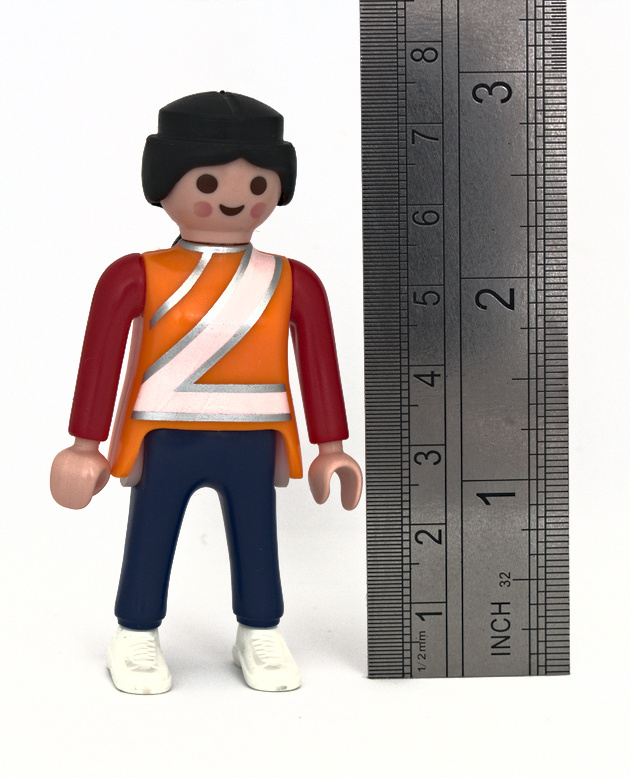Measurement and Distributions
Univariate Statistics and Methodology using R
Psychology, PPLS
University of Edinburgh
Measurement
The problem with measurement
- when we measure something, we want to identify its true measurement (the ground truth)
we don’t have any way of measuring accurately enough
our measurements are likely to be close to the truth
they might vary, if we measure more than once

Measurement
- we might expect values close to the “true” measurement to be more frequent
Something quite familiar
Dice again
the heights of the bars represent the numbers of times we obtain each value
but why are the bars not touching each other?
Dice throws aren’t really numbers
A =
B =
or
C =
or
or
- bar plot (“bar chart”) always has gaps between bars
- represents frequencies of discrete categories (
factors)
Back to playmobil

- height is a Ratio variable
- there will be limits to our precision, coventionally indicated by number of digits
| written | ⊢ min | ⊢ max |
|---|---|---|
| 7.5 | ≥ 7.450 | < 7.550 |
| 7.50 | ≥ 7.495 | < 7.505 |
Histograms
we can represent all the measurements with a histogram
the bars are touching because this represents continuous data
Histograms
we can represent all the measurements with a histogram
the bars are touching because this represents continuous data
- we know that there were 7 measurements of about 7.50 cm
- strictly, ≥ 7.495 and < 7.505 cm
Histograms (2)
note that the bin width of the histogram matters
these histograms all show the same data
Histograms in R
Histograms
the good
way to examine the distribution of data
easy to interpret (\(y\) axis = counts)
sometimes helpful in spotting weird data
the bad
changing bin width can completely change graph
only gives info about distribution and mode
- not, e.g., mean or median
Histograms
[1] 7.504 4.196 7.516 7.385 7.550 7.500 7.473 7.453 7.424 7.583 7.445 7.609
[13] 7.502 7.466 7.531 7.425 7.546 7.452 7.490 7.463 7.473 7.481 7.580 7.544
[25] 7.482 4.199 7.628 7.489 7.560 7.471 7.488 7.503 7.507 7.406 7.500 7.565
[37] 7.466 7.394 7.509 7.522 7.462 7.529 7.567 7.461 7.514 7.474 7.532 7.530
[49] 7.462 7.508 7.569 7.539 7.566 7.447 7.486 7.627 7.501 7.487 7.539 7.513
[61] 7.581 7.522 7.529 7.500 7.491 7.523 7.485 7.527 7.412 7.560 7.512 7.650Density Plots
density plots depend on a smoothing function
essentially, they’re making guesses where there is no data
Density Plots
- \(y\) axis is no longer a count
- total area under curve = “all possibilities” = 1
Density Plots
- partial area under the curve gives proportion of cases (here, 0.1885 ≥ 7.500 and < 7.525)
this is equivalent to saying that if I pick an observation \(x_i\) from this sample at random, there is a probability of .1885 that \(7.500 \le x_i < 7.525\)
The Normal Distribution
A Famous Density Plot
when we started thinking about measurement, we thought things might look a bit like this
the so-called normal curve
the normal curve is a hypothetical, asymptotic, density plot, with an area under the curve of 1
Normal Curves: Mean
normal curves can be defined in terms of two parameters
one is the centre or mean of the distribution (\(\bar{x}\), or sometimes \(\mu\))
Standard Deviation
- the other is the standard deviation (sd, or sometimes \(\sigma\))
\[\textrm{sd}=\sqrt{\frac{\sum{(x-\bar{x})^2}}{n-1}}\]
- standard deviation is the “average distance of observations from the mean”
Why Does the Height Vary?
area under the curve is always the same by sd
for ± 1 sd it’s 0.6827
there is a 68% chance of obtaining data within 1 sd of the mean
The Standard Normal Curve
we can standardize any value on any normal curve by
subtracting the mean
- the effective mean is now zero
dividing by the standard deviation
- the effective standard deviation is now one
\[ z_i = \frac{x_i - \bar{x}}{\sigma} \]
The Standard Normal Curve
- the area between 1 standard deviation below the mean and 1 standard deviation above the mean is, as we know, 0.6827
- we can ask the question the other way around: an area of .95 lies between -1.96 and 1.96 standard deviations from the mean
95% of the hypothetical observations (95% confidence interval)
Samples
Samples vs Populations
- population: all members of group you are hypothesizing about
- sample: the subset of the population you’re testing


Central Limit Theorem
lay version: sample means will be normally distributed about the true mean
if we repeatedly sample from a population, we’ll get a normal distribution of means
the mean of the distribution of means will be (close to) the population mean
the standard deviation (“width”) of the distribution of sample means is referred to as the standard error of the distribution
Central Limit Theorem (2)
if you look up CLT on Wikipedia you’ll see it’s defined in terms of adding two numbers
the sample mean is a sum of many numbers, divided by \(n\)
adding many numbers is like adding two numbers:
\[\color{red}{1 + 3 + 2} + 5 = \color{red}{(1 + 3 + 2)} + 5 = \color{red}{6} + 5\]
- dividing by something doesn’t make any difference
\(n-1\)
we’ve just shown how adding many numbers is equivalent to adding two numbers
so if we know the sum of a bunch of numbers, \(n-1\) of those numbers can be anything
| sum of n-1 numbers | nth number | sum |
|---|---|---|
| 90 | 10 | 100 |
| 102 | -2 | 100 |
| 67 | 33 | 100 |
- so if we know a summary statistic (e.g., mean, sd) we know about the data with \(n-1\) degrees of freedom
Putting it Together
the normal curve is a density plot with known properties
- it can be defined in terms of two parameters: mean, and standard deviation
if we repeatedly sample from a population and measure the mean, we’ll get a normal distribution
the mean of means will be (close to) the population mean
the standard deviation of the sample means is called the standard error
if we don’t know the population, we’ll have to estimate the population mean
we’ll want some kind of way of assessing how good our estimate is
Experiments (Unknown Population)


- in an experiment, we have access to a sample but not the population
- we have to estimate the population mean
Sample Estimates
the estimated mean is the sample mean (we have no other info)
the estimated standard error of the mean is defined in terms of the sample standard deviation
\[ \textrm{se} = \frac{\sigma}{\sqrt{n}} = \frac{\sqrt{\frac{\sum{(x-\bar{x})^2}}{n-1}}}{\sqrt{n}} \]
\[ \textrm{se} = \frac{\sigma}{\color{red}{\sqrt{n}}} = \frac{\sqrt{\frac{\sum{(x-\bar{x})^2}}{n-1}}}{\color{red}{\sqrt{n}}} \]
- the larger the sample size, the smaller the standard error
Confidence Intervals
there is only one population mean
our best estimate is the sample mean
we know that 95% of our best estimates will fall within ±1.96 standard errors of the sample mean
- we have 95% confidence that our estimation technique will capture the true mean within ±1.96 standard errors
Can We Use This For Real?
we have some survey data from the last couple of USMR classes, including height in cm
perhaps we’re interested in the “mean height of a young statistician” (!)
“young statisticians” are a population
the USMR classes are a sample
can we use the information from the sample of 304 responses we have to say anything about the population?
Looking at the Class Data
- histogram suggests that the heights are (approximately) normally distributed
Mean, Standard Deviation
Standard Error
Statistically Useful Information
- we know that the area between \(\bar{x}-1.96\sigma\) and \(\bar{x}+1.96\sigma\) is 0.95
based our sample of 304 people from the USMR class, we are 95% confident that the population mean lies between 166.9cm and 168.9cm
Statistically Useful Information
- we also have information from 3 other statistics courses
| course | mean | se | n |
|---|---|---|---|
| dapr1 | 168.0 | 0.6780 | 118 |
| dapr2 | 167.0 | 1.1239 | 48 |
| rms2 | 167.4 | 0.9750 | 67 |
| usmr | 167.9 | 0.5021 | 304 |
- are the young statisticians on those courses from different populations? (in terms of height)
Standard Errors (again)
USMR
\(\bar{x}=167.9\)
\(\text{se}=0.50\)
DAPR2
\(\bar{x}=167.0\)
\(\text{se}=1.12\)
Statistical Inference
not much evidence that DAPR2 and USMR come from different populations
inferring from samples to populations is a major goal of statistics
more about this next time